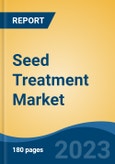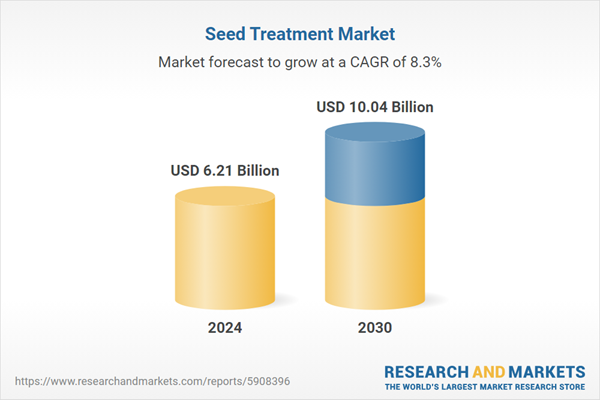Speak directly to the analyst to clarify any post sales queries you may have.
10% Free customizationThis report comes with 10% free customization, enabling you to add data that meets your specific business needs.
These treatments typically consist of fungicides, insecticides, and at times, micronutrients or growth enhancers. By enveloping the seed with a protective barrier, seed treatment effectively prevents potential threats from hampering germination and early plant growth. Moreover, seed treatment offers targeted protection precisely where it is needed, thereby minimizing the need for extensive chemical usage and reducing its overall environmental impact. Additionally, this technique often yields improved uniformity and vigor in plants, resulting in healthier crops and potentially higher yields.
The growing demand for higher agricultural productivity, coupled with the rising global population, is one of the key drivers of the seed treatment market. As arable land continues to shrink due to urbanization and industrialization, farmers are increasingly focusing on maximizing output from limited farmland. Seed treatment presents an economically viable solution to enhance seed performance, reduce crop loss, and increase yield potential without heavily relying on post-emergence crop protection chemicals. Moreover, advancements in biotechnology and the development of novel seed treatment formulations - such as biologicals and nano-coatings - are expanding the scope of applications, further fueling market growth across both developed and developing economies.
Key Market Drivers
Rising Demand for Seed Treatment Among Farmers to Improve Crop Yields
The increasing pressure on agricultural systems to meet the food needs of a growing population has made yield optimization essential. Seed treatment is becoming a popular strategy among farmers to combat seed- and soil-borne threats early in the crop cycle. According to the FAO, global crop losses due to pests and diseases account for nearly 20-40% annually, which has prompted farmers to seek preventive measures like seed treatment. This technique enables efficient delivery of protection directly to the seed, minimizing early-stage crop failure.The appeal of seed treatment lies in its cost-effectiveness and targeted nature. Unlike foliar spraying, which often requires repeated applications, seed treatments use lower volumes of agrochemicals applied precisely at the site of need. In 2023, approximately 55% of corn and 45% of soybean seeds in the U.S. were treated with a combination of fungicides and insecticides, reflecting widespread farmer adoption. This targeted protection reduces input costs and limits environmental impact, supporting sustainable agriculture goals while improving the resilience of young seedlings to pests and pathogens.
Technological advancements have further driven the adoption of seed treatment, with innovations like biological seed coatings and climate-resilient microbial formulations gaining traction. These products not only enhance disease resistance but also support nutrient uptake and stress tolerance. With increasingly erratic weather patterns, such innovations help farmers maintain yield stability. As of 2024, over 70 countries are actively integrating integrated pest management (IPM) practices, where seed treatment plays a core role. These practices are helping farmers mitigate risks and achieve better crop uniformity across different growing conditions.
The rising demand for high-quality food production has also influenced seed treatment trends. As the global population heads toward 9.7 billion by 2050, food systems must produce more with fewer resources. Seed treatment offers a proactive method to protect yield potential from the outset, reducing dependency on post-emergence chemical treatments. The increased adoption by farmers globally reflects their growing confidence in seed treatment's ability to improve germination, early vigor, and final yields. With supportive policies and innovations on the rise, seed treatment is set to remain integral to modern farming systems.
Key Market Challenges
Limited Access in Remote Areas
Limited access in remote areas plays a significant role in the expected decrease in global demand for seed treatment. While seed treatment is highly beneficial to crops, its application and efficacy are often hindered by the isolation and inaccessibility of certain regions. Farmers in these areas often lack the infrastructure, resources, and knowledge necessary to effectively apply seed treatment technologies. This challenge is compounded by the fact that remote areas often lack reliable transportation networks and logistic solutions, making it difficult for farmers to procure the necessary resources, whether it be the treatments themselves or the equipment necessary for their application.Additionally, the high cost of transportation and the time-consuming logistics of delivering these seed treatments to remote areas can deter suppliers, further reducing accessibility for farmers. As a result of these barriers, there's a growing trend towards seeking alternative, more accessible farming methods that do not rely on the use of treated seeds. This shift is expected to contribute to the decreasing global demand for seed treatment, particularly in regions with limited access.
Key Market Trends
Increase in Agricultural Activities in Developing Countries
A surge in agricultural activities worldwide, particularly in developing countries, is expected to significantly increase the demand for seed treatment. This growth can be attributed to several factors. There is a growing awareness of the benefits of seed treatment in enhancing crop yield and quality. This is especially crucial in developing countries where agriculture plays a vital role in their economies and food security is a pressing concern.These nations are facing population growth, necessitating an increase in food production to meet rising demands. This further emphasizes the importance of seed treatment to optimize the use of available arable land. The support from governments in terms of favorable policies, subsidies, and technical guidance has encouraged farming communities to adopt advanced agricultural practices, including seed treatment. Therefore, it is evident that the expansion of agricultural activities in developing nations will contribute to a global rise in seed treatment demand, driving the overall growth of the industry.
Key Market Players
- Adama Agricultural Solutions Ltd.
- Advanced Biological Marketing Inc.
- BASF SE
- Bayer Cropscience AG
- Bioworks Inc.
- Corteva Agriscience
- Germains Seed Technology
- Croda International PLC (Incotec Group BV)
- Nufarm Ltd.
- Precision Laboratories Inc.
Report Scope:
In this report, the Global Seed Treatment Market has been segmented into the following categories, in addition to the industry trends which have also been detailed below:Seed Treatment Market, By Type:
- Chemical Seed Treatment
- Non-Chemical Seed Treatment
Seed Treatment Market, By Function:
- Seed Protection
- Seed Enhancement
Seed Treatment Market, By Crop Type:
- Cereals & Grains
- Oilseeds & Pulses
- Others
Seed Treatment Market, By Application:
- Seed Coating
- Seed Dressing
- Seed Pelleting
Seed Treatment Market, By Region:
- North America
- United States
- Canada
- Mexico
- Europe
- France
- United Kingdom
- Italy
- Germany
- Spain
- Asia-Pacific
- China
- India
- Japan
- Australia
- South Korea
- South America
- Brazil
- Argentina
- Colombia
- Middle East & Africa
- South Africa
- Saudi Arabia
- UAE
Competitive Landscape
Company Profiles: Detailed analysis of the major companies present in the Global Seed Treatment Market.Available Customizations:
With the given market data, the publisher offers customizations according to a company's specific needs. The following customization options are available for the report.Company Information
- Detailed analysis and profiling of additional market players (up to five).
This product will be delivered within 1-3 business days.
Table of Contents
Companies Mentioned
The leading companies profiled in this Seed Treatment market report include:- Adama Agricultural Solutions Ltd.
- Advanced Biological Marketing Inc.
- BASF SE
- Bayer Cropscience AG
- Bioworks Inc.
- Corteva Agriscience
- Germains Seed Technology
- Croda International PLC (Incotec Group BV)
- Nufarm Ltd.
- Precision Laboratories Inc.
Table Information
| Report Attribute | Details |
|---|---|
| No. of Pages | 180 |
| Published | September 2025 |
| Forecast Period | 2024 - 2030 |
| Estimated Market Value ( USD | $ 6.21 Billion |
| Forecasted Market Value ( USD | $ 10.04 Billion |
| Compound Annual Growth Rate | 8.2% |
| Regions Covered | Global |
| No. of Companies Mentioned | 11 |









